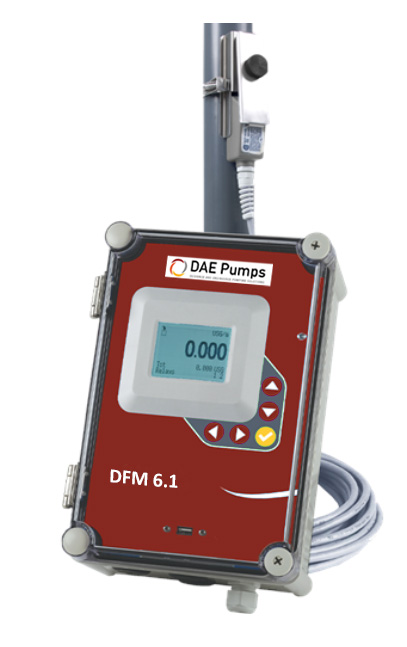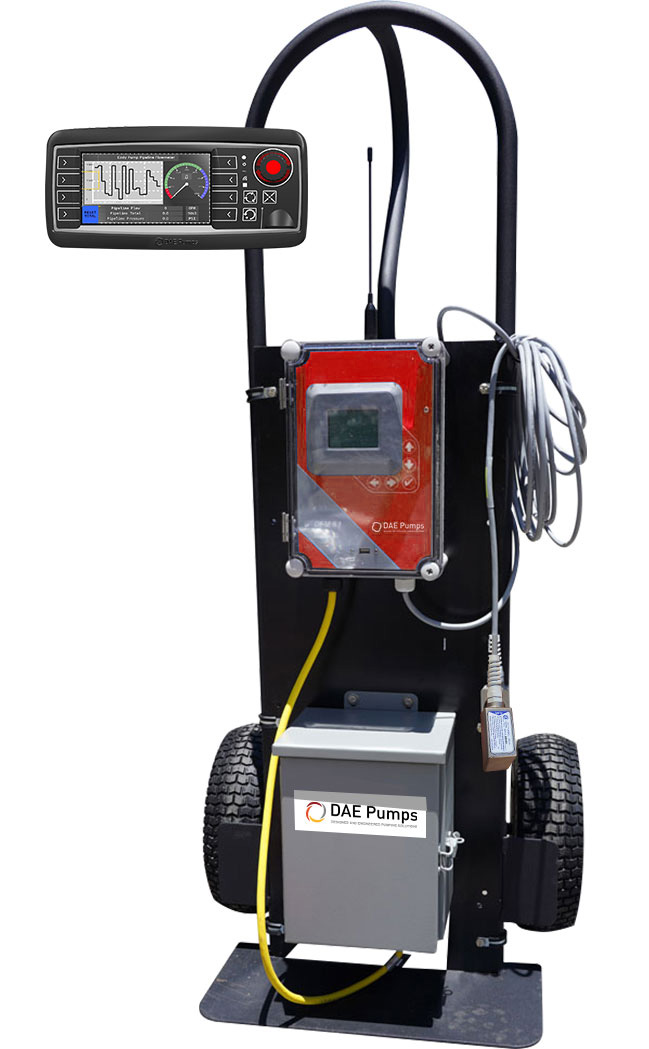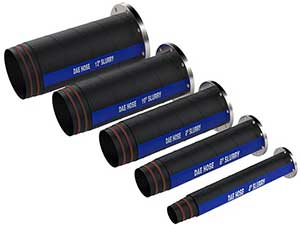UFM1000 Doppler Ultrasonic Flow Meters
DAE Pumps UFM1000 Doppler Ultrasonic Flow Meters provide a highly accurate reading of the slurry flow through the dredge hoses. The ultrasonic flow meter is suitable for monitoring sewage, mud, sludge, and a variety of abrasive solids. A clamp-on, non-intrusive transducers work well on most pipes and hoses constructed from metal or plastic. The DAE Pumps UFM1000 software automatically adjusts filtering parameters and gain settings, ensuring reliable readings over a wide range of liquid and reflector conditions. This flow meter reads any pipe inner diameter from 0.5-in to 15-ft.
UFM1000 is a completely portable package for use in a remote location. This wireless flow meter system consists of the DFM 6.1 with transducer, reader, monitor, and battery pack on a dolly. The DAE Pumps UFM1000 doppler ultrasonic flow meter is housed in a NEMA 4X (IP-66) enclosure and is configured by the user via the front panel keypad. White, backlit matrix displays flow rate, relay states, 16-digit totalizer, operating mode, and calibration menu. Power supply options available to the DAE Pumps UFM1000 doppler ultrasonic flow meter include AC or DC s, and output options include 4-20mA, rate pulse, and dual relay.
The transducer is an SE4 single-head stainless steel ultrasonic with 7.6 m (25 ft) shielded cable and designed to withstand accidental submersion to 10 psi. The transducer is rated to NEMA 6P (IP-68) and can work with temperatures up to 300°F (150°C).

Get Pricing
UFM1000 Doppler Ultrasonic Flow Meter

Benefits:
- Minimal installation time: the UFM1000 may be installed and fully operational within minutes. For most homogeneous pipe materials, there is no need to break into pipelines.
- Minimal material costs: clamp-on sensor eliminates the need for in-line flanges, pipe fittings, strainers, or filters.
- Reduced downtime: installation may be performed on full pipes and active systems. There is no need to shut down the process for installation or maintenance.
- Lower maintenance costs: with no moving parts, there is nothing on the UFM1000 to wear down.

Features:
- Non-intrusive, clamp-on transducers for most pipes from ¼” (6 mm) and above
- Wide measuring range: 0.15 to 30 FPS (0.05 to 9 MPS)
- Microprocessor-based system; configuration and accumulation data stored in non-volatile flash ROM
- Accuracy: ±2% full scale, over calibration span
- Response Time: User selectable, 6-60 seconds
- This unit connects wirelessly to the flow meter to pass data
- Flowmeter data screen showing real-time flow rates

How the Ultrasonic Flow Meter Works
The DAE Pumps UFM1000 flow meter operates by transmitting ultrasonic sound from its transmitting transducer through the pipe wall into the flowing liquid. Each transducer contains piezoelectric crystals for transmitting the signal. The sound reflects by sonic reflectors suspended within the liquid and recorded by the receiving transducer. If the reflectors are moving within the sound transmission path, sound waves get reflected at a frequency shifted (Doppler shift) from the transmitted frequency. The difference between the reflected frequencies and transmitted frequencies is directly proportional to the speed of the sonic reflectors, resulting in a liquid flow rate that is converted to various user-defined measuring units.
Slurry Hoses
The UFM1000 ultrasonic flow meter works ideally on the DAE Pumps slurry hoses for dredging and pumping. Slurry hoses provide the safe and efficient transferring of sludge, slurry, abrasive solids, and corrosive material. DAE Pumps slurry hoses are the best on the market at handling the most abrasive slurry. We offer 4-inch, 6-inch, 8-inch, 10-inch, and 12-inch hoses at lengths of up to 10 meters (33 feet).
Contact Us Today
Please contact our sales team for product questions or if you need help selecting the best dredge or pump system for your application.
Get in Touch
UFM1000 Doppler Ultrasonic Flow Meters FAQs
What is an ultrasonic flow meter?
An ultrasonic flow meter is a device used to measure the flow rate of a fluid by sending ultrasonic waves through the fluid and measuring the time it takes for the waves to travel between transducers. These meters are commonly used in various industries to accurately measure the flow of liquids, gases, and slurries.
How does a Doppler flow meter differ from a traditional ultrasonic flow meter?
A Doppler flow meter is a type of ultrasonic flow meter that operates based on the Doppler effect, which measures the frequency shift of reflected ultrasonic waves to determine flow velocity. Unlike traditional transit-time ultrasonic flow meters, which measure the time difference between upstream and downstream ultrasonic signals, Doppler flow meters are ideal for applications with suspended solids or bubbles in the fluid, such as slurries or wastewater.
What are the advantages of using a Doppler ultrasonic flow meter?
Doppler ultrasonic flow meters offer several advantages, including the ability to measure flow in fluids with high solids content or aeration, such as slurries or wastewater. They are also non-invasive and can be easily installed without disrupting the flow process, making them ideal for retrofitting existing systems or applications where access is limited.
What industries commonly use Doppler ultrasonic flow meters?
Doppler ultrasonic flow meters are used in a wide range of industries, including mining, wastewater treatment, dredging, pulp and paper, and chemical processing. Their ability to accurately measure flow in challenging fluids such as slurries makes them indispensable for applications where traditional flow measurement technologies may be ineffective.
How does a slurry flow meter differ from other types of ultrasonic flow meters?
A slurry flow meter is specifically designed to measure the flow rate of slurries, which are mixtures of solids and liquids. Unlike traditional ultrasonic flow meters, slurry flow meters are optimized to account for the presence of solids in the fluid, ensuring accurate and reliable flow measurements in challenging environments.
What factors should be considered when selecting a slurry flow meter?
When selecting a slurry flow meter, it’s essential to consider factors such as the concentration and particle size distribution of solids in the slurry, the viscosity and density of the fluid, and the desired level of accuracy and reliability. Additionally, factors such as installation requirements, maintenance considerations, and compatibility with existing systems should also be taken into account to ensure optimal performance and efficiency.





